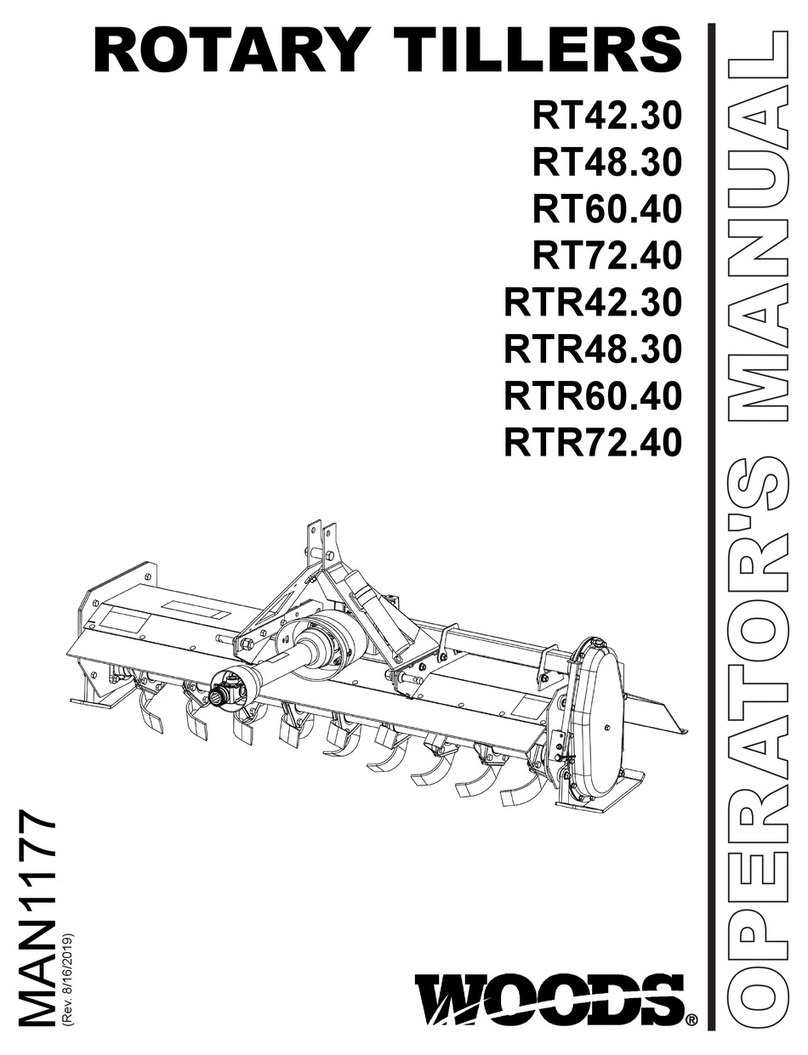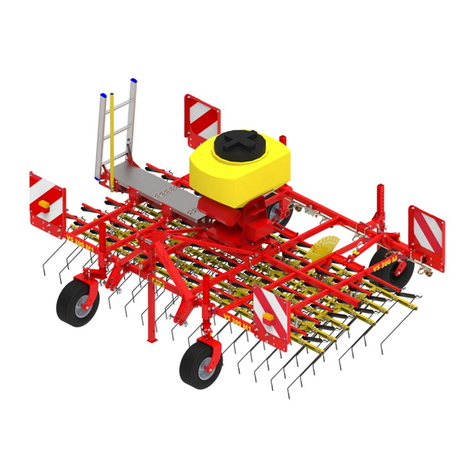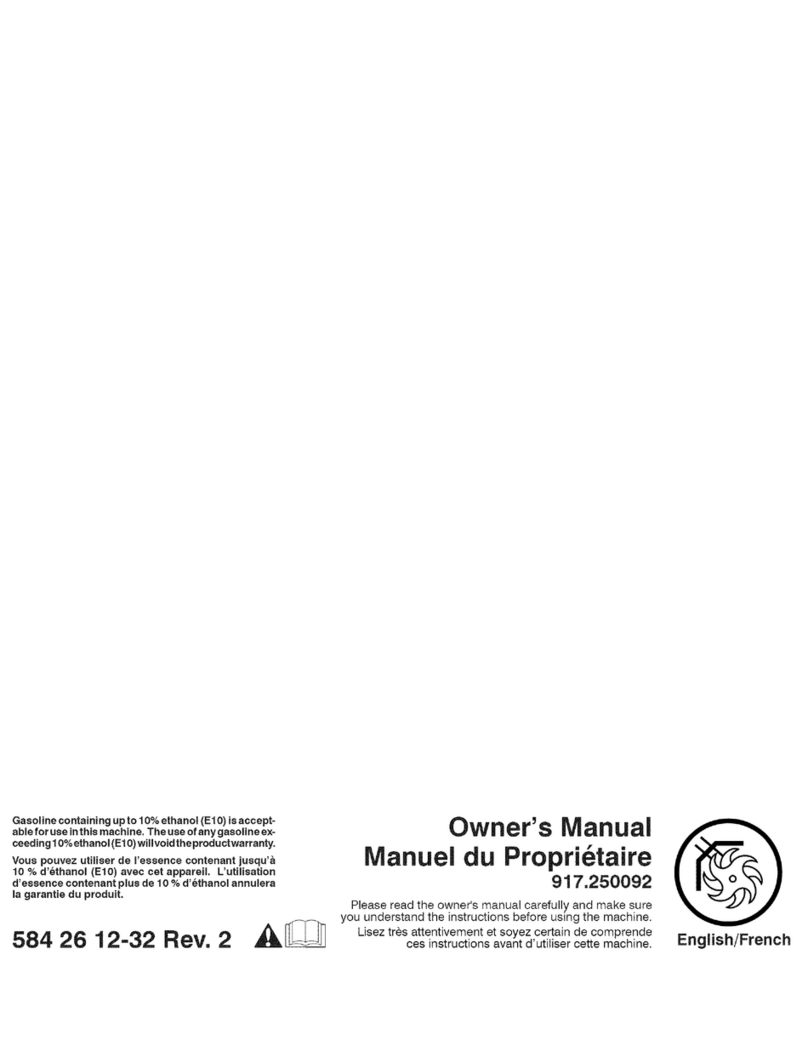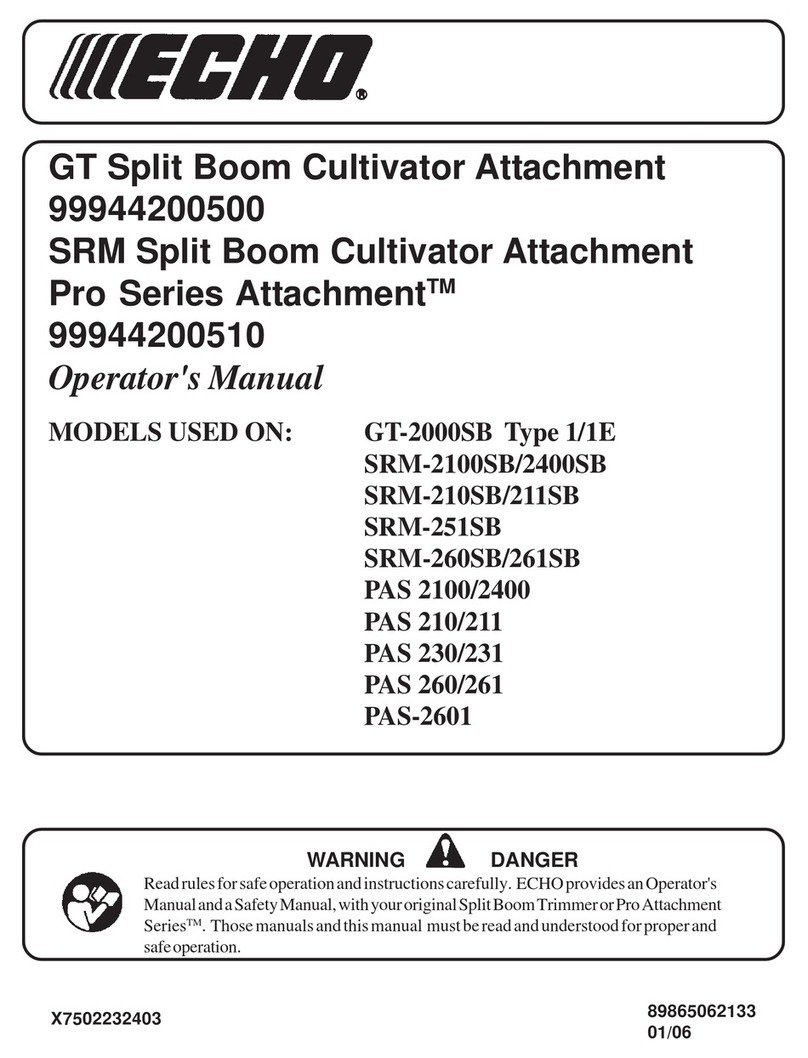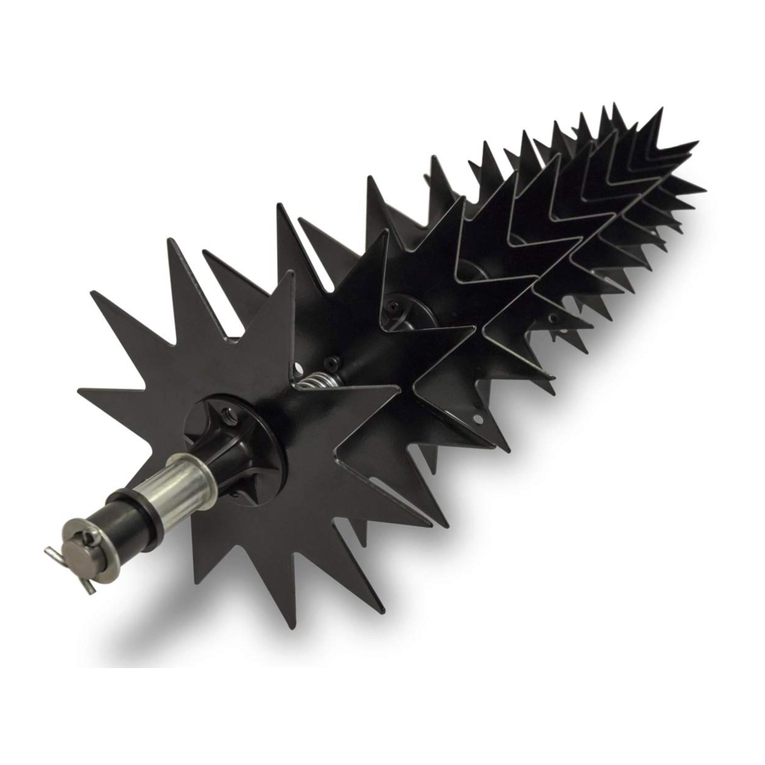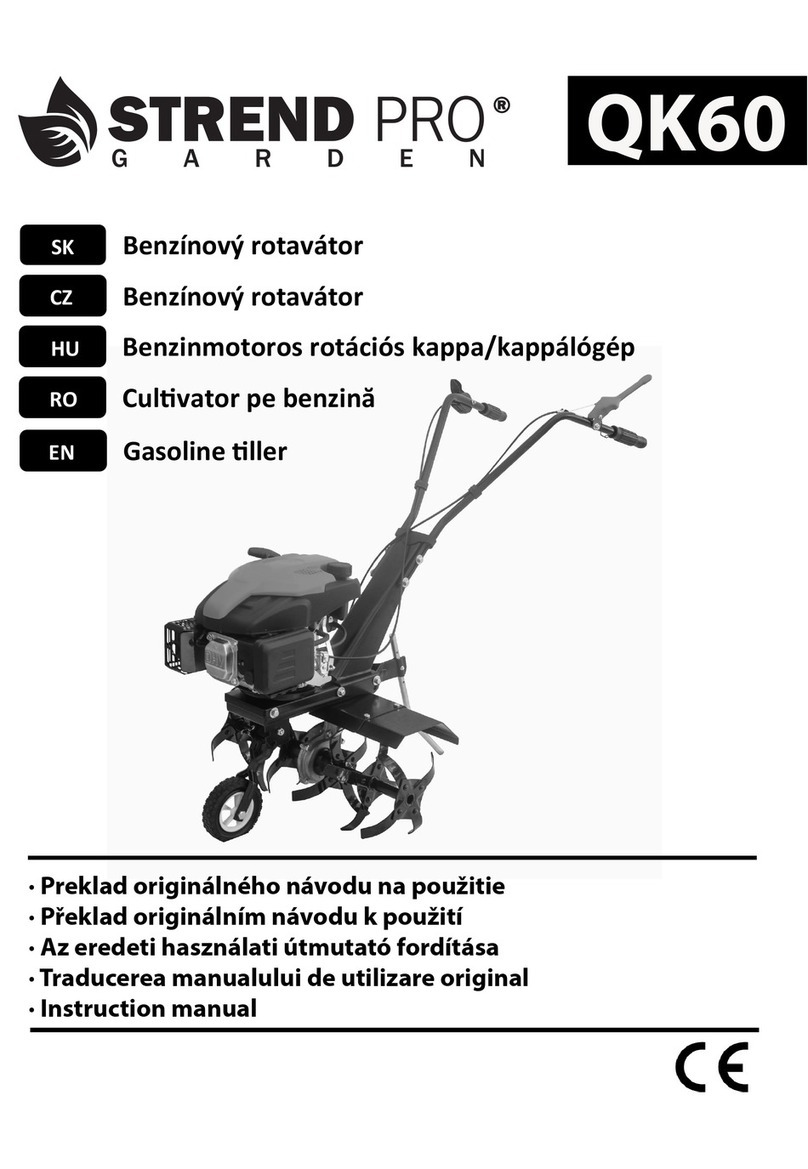Woods RT42.30 User manual

OPERATOR'S MANUALOPERATOR'S MANUAL
(Rev 07/28/2023)
MAN1177
ROTARY TILLERS
RT42.30
RT48.30
RT60.40
RT72.40
RTR42.30
RTR48.30
RTR60.40
RTR72.40

2 Introduction MAN1177
(07/28/2023)
TO THE DEALER:
Assembly and proper installation of this product is the responsibility of the Woods®dealer. Read manual instructions
and safety rules. Make sure all items on the Dealer’s Pre-Delivery and Delivery Checklists in the Operator’s Manual are
completed before releasing equipment to the owner.
The dealer must complete the online Product Registration form at the Woods Dealer Website which certies that
all Dealer Checklist items have been completed. Dealers can register all Woods product at dealer.WoodsEquipment.com
under Product Registration.
Failure to register the product does not diminish customer’s warranty rights.
TO THE OWNER:
Read this manual before operating your Woods equipment. The information presented will prepare you to do a better
and safer job. Keep this manual handy for ready reference. Require all operators to read this manual carefully and
become acquainted with all adjustment and operating procedures before attempting to operate. Replacement man-
uals can be obtained from your dealer. To obtain complete warranty details, visit WoodsEquipment.com/warranty.
You may also request a hard copy by calling 1-800-319-6637 or mail your request to: Woods Equipment Company,
Attn: Warranty Dept. 2606 South Illinois Route 2, Oregon, IL 61061. To locate your nearest dealer, check the Dealer
Locator at www.WoodsEquipment.com, or in the United States and Canada call 1-800-319-6637.
The equipment you have purchased has been carefully engineered and manufactured to provide dependable and sat-
isfactory use. Like all mechanical products, it will require cleaning and upkeep. Lubricate the unit as specied. Observe
all safety information in this manual and safety decals on the equipment.
For service, your authorized Woods dealer has trained mechanics, genuine Woods service parts, and the necessary
tools and equipment to handle all your needs.
Use only genuine Woods service parts. Substitute parts will void the warranty and may not meet standards required
for safe and satisfactory operation. Record the model number and serial number of your equipment in the spaces
provided:
Model: Date of Purchase:
Serial Number: (see Safety Decal section for location)
Provide this information to your dealer to obtain correct repair parts.
Throughout this manual, the term NOTICE is used to indicate that failure to observe can cause damage to equipment.
The terms CAUTION, WARNING, and DANGER are used in conjunction with the Safety-Alert Symbol (a triangle with
an exclamation mark) to indicate the degree of hazard for items of personal safety.
This is the safety alert symbol. It is used to alert you to potential physical
injury hazards. Obey all safety messages that follow this symbol to avoid
possible injury or death.
Indicates a hazardous situation that, if not avoided, will result in death or
serious injury.
Indicates a hazardous situation that, if not avoided, could result in death
or serious injury.
Indicates a hazardous situation that, if not avoided, could result in minor
or moderate injury.
Is used to address practices not related to physical injury.
Indicates helpful information.
DANGER
WARNING
CAUTION
or NOTICE
IMPORTANT
NOTE

Introduction 3
MAN1177
(07/28/2023)
This Operator’s Manual should be regarded as part of the machine.
Suppliers of both new and second-hand machines must make sure
that this manual is provided with the machine.
TABLE OF CONTENTS
INTRODUCTION. . . . . . . . . . . . . . . . . . . . . . . . . . . . . . . . . . . . . . . . . . . . . . .2
SPECIFICATIONS . . . . . . . . . . . . . . . . . . . . . . . . . . . . . . . . . . . . . . . . 4
GENERAL INFORMATION . . . . . . . . . . . . . . . . . . . . . . . . . . . . . . . . . . . . 4
SAFETY . . . . . . . . . . . . . . . . . . . . . . . . . . . . . . . . . . . . . . . . . . . . . . . . . . . 5
SAFETY RULES . . . . . . . . . . . . . . . . . . . . . . . . . . . . . . . . . . . . . . . . . 5
TRAINING . . . . . . . . . . . . . . . . . . . . . . . . . . . . . . . . . . . . 5
PREPARATION . . . . . . . . . . . . . . . . . . . . . . . . . . . . . . . . . . 5
OPERATION . . . . . . . . . . . . . . . . . . . . . . . . . . . . . . . . . . . 5
MAINTENANCE . . . . . . . . . . . . . . . . . . . . . . . . . . . . . . . . . 6
STORAGE . . . . . . . . . . . . . . . . . . . . . . . . . . . . . . . . . . . . 7
SAFETY & INSTRUCTIONAL DECALS . . . . . . . . . . . . . . . . . . . . . . . . . . . . . 8
OPERATION . . . . . . . . . . . . . . . . . . . . . . . . . . . . . . . . . . . . . . . . . . . . . . . . 10
OPERATION . . . . . . . . . . . . . . . . . . . . . . . . . . . . . . . . . . . . . . . . . . 10
ATTACHING ROTARY TILLER TO TRACTOR . . . . . . . . . . . . . . . . . .10
DRIVELINE ATTACHMENT. . . . . . . . . . . . . . . . . . . . . . . . . . . .11
SHORTENING DRIVELINE. . . . . . . . . . . . . . . . . . . . . . . . . . . .11
WORKING DEPTH ADJUSTMENT. . . . . . . . . . . . . . . . . . . . . . . .12
TILLER OFFSET . . . . . . . . . . . . . . . . . . . . . . . . . . . . . . . . .13
OPERATING PROCEDURE . . . . . . . . . . . . . . . . . . . . . . . . . . .14
OPERATING TECHNIQUES . . . . . . . . . . . . . . . . . . . . . . . . . . .14
PRE-OPERATION CHECKLIST . . . . . . . . . . . . . . . . . . . . . . . . .15
OWNER SERVICE. . . . . . . . . . . . . . . . . . . . . . . . . . . . . . . . . . . . . . . . . . . . . 16
OWNER SERVICE . . . . . . . . . . . . . . . . . . . . . . . . . . . . . . . . . . . . . . . 16
BLOCKING METHOD . . . . . . . . . . . . . . . . . . . . . . . . . . . . . .16
LUBRICATION . . . . . . . . . . . . . . . . . . . . . . . . . . . . . . . . . .17
PTO DRIVE LINES . . . . . . . . . . . . . . . . . . . . . . . . . . . . . . . .17
QUALIFIED TECHNICIAN MAINTENANCE . . . . . . . . . . . . . . . . . . .17
CLEANING . . . . . . . . . . . . . . . . . . . . . . . . . . . . . . . . . . . .18
BLADE INSTALLATION. . . . . . . . . . . . . . . . . . . . . . . . . . . . . .19
TROUBLESHOOTING. . . . . . . . . . . . . . . . . . . . . . . . . . . . . . . . . . . . . . . . . . . 20
DEALER SERVICE . . . . . . . . . . . . . . . . . . . . . . . . . . . . . . . . . . . . . . . . . . . . 21
DEALER SERVICE . . . . . . . . . . . . . . . . . . . . . . . . . . . . . . . . . . . . . . . 21
GEARBOX MAINTENANCE . . . . . . . . . . . . . . . . . . . . . . . . . . .21
UNIVERSAL JOINT REPAIR . . . . . . . . . . . . . . . . . . . . . . . . . . .22
ASSEMBLY . . . . . . . . . . . . . . . . . . . . . . . . . . . . . . . . . . . . . . . . . . . . . . . . 24
ASSEMBLY . . . . . . . . . . . . . . . . . . . . . . . . . . . . . . . . . . . . . . . . . . . 24
DEALER SET-UP INSTRUCTIONS . . . . . . . . . . . . . . . . . . . . . . .24
DISASSEMBLE SHIPPING UNIT. . . . . . . . . . . . . . . . . . . . . . . . .24
ASSEMBLY PROCEDURES . . . . . . . . . . . . . . . . . . . . . . . . . . .24
DEALER CHECKLISTS . . . . . . . . . . . . . . . . . . . . . . . . . . . . . . . . . . . . . . . . . . 26
PARTS INDEX . . . . . . . . . . . . . . . . . . . . . . . . . . . . . . . . . . . . . . . . . . . . . . . 27
INDEX . . . . . . . . . . . . . . . . . . . . . . . . . . . . . . . . . . . . . . . . . . . . . . . . . . . 37
APPENDIX. . . . . . . . . . . . . . . . . . . . . . . . . . . . . . . . . . . . . . . . . . . . . . . . . 38
BOLT TORQUE CHART . . . . . . . . . . . . . . . . . . . . . . . . . . . . . . . . . . . . 38
BOLT SIZE CHART & ABBREVIATIONS . . . . . . . . . . . . . . . . . . . . . . . . . . . . 39

4 Introduction MAN1177
(07/28/2023)
SPECIFICATIONS
RT42.30/RTR42.30 RT48.30/RTR48.30 RT60.40/RTR60.40 RT72.40/RTR72.40
Tilling Width 41" 47" 59" 71"
Maximum Tilling Depth 7" 7" 7" 7"
Operating Weight 478 lbs / 483 lbs 502 lbs / 507 lbs 570 lbs / 578 lbs 628 lbs / 636 lbs
Rotor Swing Diameter 15" 15" 15" 15"
Number of Blade Flanges 5 6 7 9
Number of Blades 20 24 28 36
Drive Type Gear Gear Gear Gear
Tractor PTO Speed 540 RPM
Rotor Speed 210 RPM
Tractor Hitch Limited Category 1 & Category 1 Category 1
Tractor Horsepower 12 - 30 HP 15 - 35 HP 18 - 40 HP 20 - 50 HP
Skid Shoe Adjustments 5 x 1" 5 x 1" 5 x 1" 5 x 1"
Offset 3" 3" 2.3" 2.3"
Gearbox Oil Capacity 1.2 Qt SAE 80W-90
Side Drive Oil Capacity 3 QT SAE 80W-90
GENERAL INFORMATION
■Some illustrations in this manual show the
mower with safety shields removed to provide a
better view. The mower should never be operat-
ed with any safety shielding removed.
The purpose of this manual is to assist you in oper-
ating and maintaining your cutter. Read it carefully.
It furnishes information and instructions that will help
you achieve years of dependable performance. These
instructions have been compiled from extensive eld
experience and engineering data. Some information
may be general in nature due to unknown and vary-
ing operating conditions. However, through experience
and these instructions, you should be able to develop
procedures suitable to your particular situation.
The illustrations and data used in this manual were cur-
rent at the time of printing but, due to possible inline
production changes, your machine may vary slightly in
detail. We reserve the right to redesign and change the
machines as may be necessary without notication.
Throughout this manual, references are made to right
and left directions. These are determined by standing
behind the equipment facing the direction of forward
travel. Blade rotation is clockwise (left wing) and coun-
terclockwise (right wing and center section) as viewed
from the top of the cutter.
WARNING
¡LEA EL INSTRUCTIVO!
Si no lee Ingles, pida ayuda a
alguien que si lo lee para que le
traduzca las medidas de seguridad.

Safety 5
MAN1177
(07/28/2023)
TRAINING
■Safety instructions are important! Read all
attachment and power unit manuals; follow
all safety rules and safety decal information.
(Replace- ment manuals and safety decals are
available from your dealer. To locate your near-
est dealer, check the Dealer Locator at www.
WoodsEquipment.com, or in the United States
and Canada call 1-800-319- 6637.) Failure to
follow instructions or safety rules can result in
serious injury or death.
■If you do not understand any part of this manual
and need assistance, see your dealer.
■Know your controls and how to stop engine and
attachment quickly in an emergency.
■Operators must be instructed in and be capa-
ble of the safe operation of the equipment, its
attachments, and all controls. Do not allow any-
one to operate this equipment without proper
instructions.
■Never allow children or untrained persons to op-
erate equipment.
PREPARATION
■Check that all hardware is properly installed.
Always tighten to torque chart specications
unless instructed otherwise in this manual.
■Always wear relatively tight and belted clothing
to avoid getting caught in moving parts. Wear
sturdy, rough-soled work shoes and protec-
tive equipment for eyes, hair, hands, hearing,
and head; and respirator or lter mask where
appropriate.
■Make sure attachment is properly secured, ad-
justed, and in good operating condition.
■Make sure spring-activated locking pin or collar
slides freely and is seated rmly in tractor PTO
spline groove.
■Before putting equipment into service, check
and adjust driveline length as instructed in
Operator’s Manual. Driveline must not bottom
out or pull apart throughout the full range of
the tractor hitch. Do not operate until driveline
length is correct.
■Before starting power unit, check all equipment
driveline guards for damage. Replace any dam-
aged guards. Make sure all guards rotate freely
on all drivelines. If guards do not rotate freely on
drive-lines, repair and replace bearings before
putting equipment into service.
■Power unit must be equipped with ROPS or
ROPS cab and seat belt. Keep seat belt secure-
ly fastened. Falling off power unit can result in
death from being run over or crushed. Keep
foldable ROPS systems in “locked up” position
at all times.
■Remove accumulated debris from this equip-
ment, power unit, and engine to avoid re
hazard.
■Make sure all safety decals are installed.
Replace if damaged. (See Safety Decals section
for location.)
■Make sure shields and guards are proper-
ly installed and in good condition. Replace if
damaged.
■A minimum 20% of tractor and equipment
weight must be on the tractor front wheels when
attachments are in transport position. Without
this weight, front tractor wheels could raise up
resulting in loss of steering. The weight may
be attained with front wheel weights, ballast in
tires, front tractor weights or front loader. Weigh
the tractor and equipment. Do not estimate.
■Inspect and clear area of stones, branches, or
other hard objects that might be thrown, caus-
ing injury or damage.
OPERATION
■Only engage power when equipment is at ground
operating level. Always disengage power when
equipment is raised off the ground.
■Do not allow bystanders in the area when op-
erating, attaching, removing, assembling, or
servicing equipment.
■Keep bystanders away from equipment.
■Never direct discharge toward people, animals,
or property.
Safety is a primary concern in the design and man-
ufacture of our products. Unfortunately, our efforts
to provide safe equipment can be wiped out by an
operator’s single careless act.
In addition to the design and conguration of
equipment, hazard control and accident preven-
tion are dependent upon the awareness, concern,
judgement, and proper training of personnel in-
volved in the operation, transport, maintenance,
and storage of equipment.
It has been said, “The best safety device is an in-
formed, careful operator.” We ask you to be that
kind of operator.
SAFETY RULES
ATTENTION! BECOME ALERT! YOUR SAFETY IS INVOLVED!

6 Safety MAN1177
(07/28/2023)
■ Do not operate equipment while under the inu-
ence of alcohol or drugs.
■ Operate only in daylight or good articial light.
■Keep hands, feet, hair, and clothing away from
equipment while engine is running. Stay clear of
all moving parts.
■Always comply with all state and local lighting
and marking requirements.
■Never allow riders on power unit or attachment.
■Power unit must be equipped with ROPS or
ROPS cab and seat belt. Keep seat belt secure-
ly fastened. Falling off power unit can result in
death from being run over or crushed. Keep
foldable ROPS systems in “locked up” position
at all times.
■Always sit in power unit seat when operating
controls or starting engine. Securely fasten
seat belt, place transmission in neutral, engage
brake, and ensure all other controls are disen-
gaged before starting power unit engine.
■Operate tractor PTO at 540 RPM. Do not exceed.
■Do not operate PTO during transport.
■Connect PTO driveline directly to power unit
PTO shaft. Never use adapter sleeves or adapt-
er shafts. Adapters can cause driveline failures
due to incorrect spline or incorrect operating
length and can result in personal injury or death.
■Look down and to the rear and make sure area is
clear before operating in reverse.
■Use extreme care when working close to fences,
ditches, other obstructions, or on hillsides.
■Do not operate or transport on steep slopes.
■Do not stop, start, or change directions sudden-
ly on slopes.
■Use extreme care and reduce ground speed on
slopes and rough terrain.
■Watch for hidden hazards on the terrain during
operation.
■Stop power unit and equipment immediately
upon striking an obstruction. Turn off engine,
set parking brake, remove key, inspect, and re-
pair any damage before resuming operation.
■Before performing any service or maintenance,
disconnect driveline from tractor PTO.
■Before dismounting power unit or perform-
ing any service or maintenance, follow these
steps: disengage power to equipment, lower
the 3-point hitch and all raised components to
the ground, operate valve levers to release any
hydraulic pressure, set parking brake, stop en-
gine, remove key, and unfasten seat belt.
■Never go underneath equipment (lowered to the
ground or raised) unless it is properly blocked
and secured. Never place any part of the body
underneath equipment or between moveable
parts even when the engine has been turned off.
Hydraulic system leak down, hydraulic system
failures, mechanical failures, or movement of
control levers can cause equipment to drop or
rotate unexpectedly and cause severe injury or
death. Follow Operator’s Manual instructions
for working underneath and blocking require-
ments or have work done by a qualied dealer.
MAINTENANCE
■Service and maintenance work not covered in
OWNER SERVICE must be done by a qualied
dealership. Special skills, tools, and safety pro-
cedures may be required. Failure to follow these
instructions can result in serious injury or death.
■Before performing any service or maintenance,
disconnect driveline from tractor PTO.
■Before dismounting power unit or perform-
ing any service or maintenance, follow these
steps: disengage power to equipment, lower
the 3-point hitch and all raised components to
the ground, operate valve levers to release any
hydraulic pressure, set parking brake, stop en-
gine, remove key, and unfasten seat belt.
■Never go underneath equipment (lowered to the
ground or raised) unless it is properly blocked
and secured. Never place any part of the body
underneath equipment or between moveable
parts even when the engine has been turned off.
Hydraulic system leak down, hydraulic system
failures, mechanical failures, or movement of
control levers can cause equipment to drop or
rotate unexpectedly and cause severe injury or
death. Follow Operator’s Manual instructions
for working underneath and blocking require-
ments or have work done by a qualied dealer.
SAFETY RULES
ATTENTION! BECOME ALERT! YOUR SAFETY IS INVOLVED!

Safety 7
MAN1177
(07/28/2023)
■Do not modify or alter or permit anyone else to
modify or alter the equipment or any of its com-
ponents in any way.
■Your dealer can supply original equipment hy-
draulic accessories and repair parts. Substitute
parts may not meet original equipment speci-
cations and may be dangerous.
■Always wear relatively tight and belted clothing
to avoid entanglement in moving parts. Wear
sturdy, rough-soled work shoes and protective
equipment for eyes, hair, hands, hearing, and
head.
■Do not allow bystanders in the area when op-
erating, attaching, removing, assembling, or
servicing equipment.
■Make sure attachment is properly secured, ad-
justed, and in good operating condition.
■Never perform service or maintenance with en-
gine running.
■Keep all persons away from operator control
area while performing adjustments, service, or
maintenance.
■Tighten all bolts, nuts, and screws to torque
chart specications. Check that all cotter pins
are installed securely to ensure equipment is in
a safe condition before putting unit into service.
■Make sure all safety decals are installed.
Replace if damaged. (See Safety Decals section
for location.)
■Make sure shields and guards are proper-
ly installed and in good condition. Replace if
damaged.
■ Use a suitable lifting device of sufcient capac-
ity. Use adequate personnel to handle heavy
components.
STORAGE
■Follow manual instructions for storage.
■Keep children, bystanders and animals away
from equipment and storage area.
SAFETY RULES
ATTENTION! BECOME ALERT! YOUR SAFETY IS INVOLVED!

8 Safety MAN1177
(07/28/2023)
CD8614
5
8
4
2 - SHIELD REMOVED
FOR DECAL
VISIBILITY
3
7
4
7
5
6
9
1
1 - SERIAL NUMBER PLATE
SAFETY & INSTRUCTIONAL DECALS
ATTENTION! BECOME ALERT! YOUR SAFETY IS INVOLVED!
Replace Immediately If Damaged!
2 - PN 18868 3 - PN 18866
4 - PN 18864 5 - PN P0021
SHIELD MISSING
DO NOT OPERATE
PUT SHIELD ON
DANGER
18868-B
DO NOT EXCEED PTO SPEED OF
WARNING
18866
PTO speeds higher than 540 RPM
can cause equipment failure and
personal injury.
540 RPM
DANGER
ROTATING DRIVELINE
CONTACT CAN CAUSE DEATH
KEEP AWAY!
DO NOT OPERATE WITHOUT -
nAll driveline guards, tractor and equipment
shields in place.
nDrivelines securely attached at both ends.
nDriveline guards that turn freely on driveline.
18864-C

Safety 9
MAN1177
(07/28/2023)
SAFETY & INSTRUCTIONAL DECALS
ATTENTION! BECOME ALERT! YOUR SAFETY IS INVOLVED!
Replace Immediately If Damaged!
9 - PN 33347
6 - PN 55122 7 - PN 1002941 8 - PN 1004299
WARNING
CRUSHING AND
PINCHING HAZARD
■ Be extremely careful
handling various parts of the
machine. They are heavy and
hands, fingers, feet, and
other body parts could be
crushed or pinched between
tractor and implement.
■ Operate tractor controls from
tractor seat only.
■ Do not stand between tractor
and implement when tractor
is in gear.
■ Make sure parking brake is
engaged before going
between tractor and
implement.
■ Stand clear of machine while
in operation or when it is
being raised or lowered.
FAILURE TO FOLLOW THESE
INSTRUCTIONS COULD
RESULT IN SERIOUS INJURY
OR DEATH.
1002941-A
3” x 7”
Black and PMS 151
WARNING
FALLING OFF
CAN RESULT IN
BEING RUN OVER.
•Tractor must be equipped
with ROPS (or ROPS CAB)
and seat belt. Keep foldable
ROPS systems in "locked
up" position at all times.
•Buckle Up! Keep seat belt
securely fastened.
•Allow no riders.
RAISED IMPLEMENT
CAN DROP AND CRUSH.
•Never go underneath raised
implement which can drop
from equipment or tractor
3-point hitch hydraulic leak
down, hydraulic system
failures, movement of
control levers, or
mechanical linkage failures.
•Service work does not
require going underneath
implement. Read manual
instructions.
FALLING OFF OR GOING
UNDERNEATH IMPLEMENT
CAN RESULT IN SERIOUS
INJURY OR DEATH. 1004299
BE CAREFUL!
Keep safety decals clean and visible.
Use a clean, damp cloth to clean safety decals.
Avoid spraying too close to decals when using a pressure washer;
high-pressure water can enter through very small scratches or
under edges of decals causing them to peel or come off.
Replace safety decals if they are missing or illegible.
Replacement safety decals can be ordered free from your Woods
dealer, or in the United States and Canada call 1-800-319-6637.

10 Operation MAN1177
(07/28/2023)
OPERATION
The RT rotary tiller is designed for completion of plow-
ing operations and seedbed preparation. It breaks up
clods, levels the soil surface, destroys weeds, and mix-
es in fertilizer. Refer to the information in this manual for
the specications, parts, assemblies, and adjustments.
The operator is responsible for the safe operation of
this rotary tiller. The operator must be properly trained.
Operators should be familiar with the tractor, tiller, and
all safety practices before starting operation. Read the
safety rules and safety decals on page 5 through page
9.
■Safety instructions are important! Read all
attachment and power unit manuals; follow
all safety rules and safety decal information.
(Replace- ment manuals and safety decals are
available from your dealer. To locate your near-
est dealer, check the Dealer Locator at www.
WoodsEquipment.com, or in the United States
and Canada call 1-800-319- 6637.) Failure to
follow instructions or safety rules can result in
serious injury or death.
■Power unit must be equipped with ROPS or
ROPS cab and seat belt. Keep seat belt secure-
ly fastened. Falling off power unit can result in
death from being run over or crushed. Keep
foldable ROPS system in “locked up” position
at all times.
■Do not allow bystanders in the area when op-
erating, attaching, removing, assembling, or
servicing equipment.
■Never allow children or untrained persons to op-
erate equipment.
■Never go underneath equipment (lowered to the
ground or raised) unless it is properly blocked
and secured. Never place any part of the body
underneath equipment or between moveable
parts even when the engine has been turned off.
Hydraulic system leak down, hydraulic system
failures, mechanical failures, or movement of
control levers can cause equipment to drop or
rotate unexpectedly and cause severe injury or
death. Follow Operator’s Manual instructions
for working underneath and blocking require-
ments or have work done by a qualied dealer.
■Before dismounting power unit or perform-
ing any service or maintenance, follow these
steps: disengage power to equipment, lower
the 3-point hitch and all raised components to
the ground, operate valve levers to release any
hydraulic pressure, set parking brake, stop en-
gine, remove key, and unfasten seat belt.
■Make sure spring-activated locking pin or collar
slides freely and is seated rmly in tractor PTO
spline groove.
■Operate tractor PTO at 540 RPM. Do not exceed.
■Make sure attachment is properly secured, ad-
justed, and in good operating condition.
ATTACHING ROTARY TILLER
TO TRACTOR
1. Move the tractor into position in front of the tiller.
Move back slowly and carefully, not allowing any-
one to be between the tractor and the tiller.
2. Turn off tractor engine.
3. Place the two lower arms of the 3-point hitch over
outer hitch pins. Secure with klik pin. (not provided).
4. Attach the tractor center link to the upper hitch point
of the rotary tiller. Adjust the length of the center link
until the tops of the frame ends are parallel to the
ground.
5. Adjust the tractor lower 3-point arm anti-sway devic-
es to prevent tiller from swinging side to side during
transport.
6. Attach the front PTO driveline from the rotary tiller to
the tractor. (Slide the front section of the PTO drive-
line into the back section. Slide the PTO shaft onto
the rear PTO output of the tractor).
■If the PTO driveline is too long, severe driveline
and gearbox damage is possible when hooking
up the PTO driveline from the rotary tiller to the
tractor. The front PTO driveline is long enough
to t a variety of tractors. It is possible that the
front PTO driveline will need to be cut. There will
be NO benet by cutting only one telescoping
section. Both sections of the driveline must be
cut. DO NOT FORCE THE PTO TO FIT.
■WARRANTY IS VOID IF THE PTO DRIVELINE IS
TOO LONG, resulting in gearbox, PTO, yoke or
cross bearing damage.
NOTE: The PTO driveline, when attached to the
tractor and gearbox, must not extend so there is
less than four inches of overlap within the PTO
driveline.
WARNING
NOTICE

Operation 11
MAN1177
(07/28/2023)
7. Raise park stand and secure in operating position.
Figure 1. Park Stand - Operating Position
Figure 2. Park Stand - Storage Position
DRIVELINE ATTACHMENT
Attach the rotary tiller to the tractor 3-point hitch (or
quick hitch if available). Do not attach driveline. Raise
and lower the tiller to determine maximum and mini-
mum distance between the tractor PTO shaft and the
gearbox input shaft. If the distance is too large, the
driveline will be too short for proper engagement. If the
distance is too small, the driveline may bottom out in
operation and damage the tiller or tractor.
If the driveline is too short, please call your Woods
dealer for a longer driveline.
If the driveline is too long, please follow the instructions
for shortening the driveline.
SHORTENING DRIVELINE
1. Move the tiller up and down to get the shortest
possible distance between tractor PTO shaft and
gearbox input shaft. Leave the tiller in the minimum
distance position. Install jack stands under the tiller
for support.
2. Separate the driveline into two halves and connect
them to the tractor and the gearbox.
3. Place driveline halves parallel to one another to de-
termine how much to shorten the driveline.
Figure 3. Drive Halves Placed Parallel
4. Measure from end of the upper shield to the base
of the bell on the lower shield (A). Add 1-1/2" to di-
mension (A).

12 Operation MAN1177
(07/28/2023)
Figure 4. Determine Shield Length
5. Cut the upper shield to this overall dimension.
Figure 5. Cut Shield
6. Place the cut portion of the shield against the end of
the shaft and use as a guide. Mark and cut the shaft.
Figure 6. Cut Shaft to Length
7. Repeat step 6 for the other half of the drive.
8. File and clean the cut ends of both drive halves.
Ensure the drive halves slide smoothly together.
Do not run the tractor if proper driveline engagement
cannot be obtained through these methods.
Connect the driveline to tractor PTO shaft, making sure
the spring-activated locking collar slides freely and
locks driveline to PTO shaft.
■If attaching with quick hitch, the distance be-
tween the tractor PTO and gearbox input
shaft will increase. Please follow the steps as
you would for a 3-point hitch to insure proper
engagement.
WORKING DEPTH ADJUSTMENT
■Keep all persons away from operator control
area while performing adjustments, service, or
maintenance.
1. Raise the tiller off the ground.
2. Level tiller side to side. Check by measuring from
the forward skid shoe pivot to the ground on each
side. (Figure 7)
3. Adjust, using tractor 3-point arm leveling device.
NOTE: Keep the front of the tiller parallel to the
ground.
4. Place two jack-stands under the tiller rotor shaft.
Figure 7. Leveling the Tiller
5. Loosen the 1/2" cap screws that act as the front piv-
ots to the skid shoes. Remove the 1/2" cap- screws
(46) that hold the rear of the skid shoes to the tiller
frame.
6. Adjust the skid shoe to the desired tilling depth
(Figure 8). Reinstall the cap screws in the rear of
the skid shoe and tighten all cap screws.
NOTICE
WARNING
MEASURE BOTH
ENDS TO GROUND
PARALLEL TO GROUND
CD8615
A
1-1/2"

Operation 13
MAN1177
(07/28/2023)
Figure 8. Tiller Depth Adjustment
NOTE: Tillage depth is dependent on ground hardness,
tractor speed, skid shoe setting, and tractor hitch ad-
justment. Multiple passes may be necessary to achieve
tillage depth.
TILLER OFFSET
The RT tillers come with a xed gearbox offset, so that
the tiller can cover a tractor tire width larger than its
width. The offset is to the right as sitting in the tractor
seat. By tilling in a clockwise rotation, tire tracks can be
reduced or eliminated. Below is a chart which outlines
the tractor width that can be paired with a tiller.
Figure 9. Tiller Offset Chart
Figure 10. Tiller Offset
Figure 11. Tilling Direction
Tiller Model Offset Covered Width
RT42.30 3" 48"
RT48.30 3" 54"
RT60.40 2.25" 64.5"
RT72.40 2.25" 76.5"
5
4
3
21
1/2NC FLANGE NUT
1/2NC CAP SCREW
CD8616
Hole First Pass
Depth
1 0"
2 1"
3 2"
4 3"
5 4"
RT42.30 OFFSET
3"
OFFSET
24"
42"
CD8617
CD8617
TILLING DIRECTION TO COVER
TRACTOR TIRE TRACKS

14 Operation MAN1177
(07/28/2023)
OPERATING PROCEDURE
■Only engage power when equipment is at ground
operating level. Always disengage power when
equipment is raised off the ground.
Read and understand the rotary tiller and tractor op-
erator’s manuals before operating the tiller. Failure to
do so may result in death, serious personal injury or
property damage.
Never raise the tiller more than a few inches off the
ground when traveling from job site to job site.
Shut off the engine, set brake, remove key and remove
seat belt. Dismount the tractor.
Tractor Stability
■A minimum 20% of tractor and equipment weight
must be on the tractor front wheels when attach-
ments are in transport position. Without this
weight, tractor could tip over, causing personal
injury or death. The weight may be attained with
a loader or front tractor weights. Weigh the trac-
tor and equipment. Do not estimate.
Figure 12. Tractor Stability (Typical)
Clutch Run-In
Clutch run-in must be done prior to initial use and
before each season or whenever tiller has been set-
ting idle for more than two months. See Slip Clutch
Adjustment page 18 for the run-in procedure.
After you have completed the run-in of the clutch, re-
turn to the operating instructions and proceed with
start-up. Failure to run the clutch in could result in pre-
mature driveline failure and warranty will be voided.
Start-Up Sequence
1. Start tractor engine.
2. Lower tiller slowly, nearly to the ground.
3. Engage tractor PTO.
4. Lower the tiller completely to the ground.
5. Increase engine rpm to normal operating speed of
540 rpm.
6. Move tractor forward. Select a slow tractor speed
and increase slightly until operation is satisfactory.
Rear Shield Adjustment
The rotary tiller tailgate can be adjusted to control the
tilth of the soil. The nest nish is achieved with the
tailgate at the lowest adjustment. As the tailgate is
raised, or adjusted up, the nish of the soil will become
more coarse. Raising the tailgate reduces the amount
of recirculation that occurs to the soil inside the tiller
housing. If the soil conditions are very rocky, the tail-
gate should be run in a raised position so rocks may
pass through the tiller more quickly.
■Do not drop tiller to the ground with the rotor
turning. Sudden high speed jolts multiply stress
to the driveline and can cause extreme damage.
OPERATING TECHNIQUES
Tilling Sod and Untilled Ground
For tearing up untilled sod or conditioning compacted
soils, several shallow passes will be most productive.
Set the skid shoes to one of the two most shallow posi-
tions. A gear should be selected on the tractor for a
slow travel speed. Progressive passes can be done at
progressively faster speeds.
■ After tilling for the rst half hour, check for
loose blades and retighten any loose hardware.
Follow the shutdown procedure and blocking
method before checking blades.
Previously Tilled Ground
To pulverize the topsoil and prepare a good seedbed,
set the skid shoes for a tilling depth equivalent to your
deepest roots. Adjust the tailgate to the fully lowered
position. A tractor gear should be selected such that
the tiller does not lug the engine.
WARNING
WARNING
CD1564-2
NOTICE
NOTICE

Operation 15
MAN1177
(07/28/2023)
PRE-OPERATION CHECKLIST
(OWNER’S RESPONSIBILITY)
Review and follow all safety rules and safety de-
cal instructions on pages 5 through 9.
Check that all safety decals are installed and in
good condition. Replace if damaged.
Check that all shields and guards are proper-
ly installed and in good condition. Replace if
damaged.
Check that all hardware is properly installed and
secured.
Check that equipment is properly and securely
attached to tractor.
Before starting tractor, check all equipment
driveline guards for damage and make sure
they rotate freely on all drivelines. Replace any
damaged guards. If guards do not rotate freely
on drivelines, repair and replace bearings before
operating.
Do not allow riders.
Make sure driveline spring-activated locking col-
lar slides freely and is seated rmly in tractor
PTO spline groove.
Keep all bystanders away from equipment work-
ing area.
Check all lubrication points and grease as
instructed in the Lubrication Maintenance illus-
tration, page 17.
Make sure tractor ROPS or ROPS CAB and seat
belt are in good condition. Keep foldable ROPS
systems in “locked up” position at all times. Keep
seat belt securely fastened during operation.
Check to be sure gear lube runs out of the small
check plug on the side of each gearbox.
Check the condition of the tiller blades. Replace
any blades that are broken or excessively worn.
Check for objects that may be wound around
the tiller rotor shaft. Objects like wire, string, tall
grass and weeds can build up on the rotor shaft
and affect tiller operation.

16 Owner Service MAN1177
(07/28/2023)
OWNER SERVICE
The information in this section is written for operators
who possess basic mechanical skills. If you need help,
your dealer has trained service technicians available.
For your protection, read and follow the safety informa-
tion in this manual.
■Keep all persons away from operator control
area while performing adjustments, service, or
maintenance.
■Make sure shields and guards are proper-
ly installed and in good condition. Replace if
damaged.
■Make sure all safety decals are installed. Replace
if damaged. (See Safety Decals section for
location.)
■If you do not understand any part of this manual
and need assistance, see your dealer.
■Always wear relatively tight and belted clothing
to avoid entanglement in moving parts. Wear
sturdy, rough-soled work shoes and protec-
tive equipment for eyes, hair, hands, hearing,
and head; and respirator or lter mask where
appropriate.
BLOCKING METHOD
■Before performing any service or maintenance,
disconnect driveline from tractor PTO.
■Before dismounting power unit or perform-
ing any service or maintenance, follow these
steps: disengage power to equipment, lower
the 3-point hitch and all raised components to
the ground, operate valve levers to release any
hydraulic pressure, set parking brake, stop en-
gine, remove key, and unfasten seat belt.
■Do not allow bystanders in the area when op-
erating, attaching, removing, assembling, or
servicing equipment.
■Never perform service or maintenance with en-
gine running.
■Do not modify or alter or permit anyone else to
modify or alter the equipment or any of its com-
ponents in any way.
■Never go underneath equipment (lowered to the
ground or raised) unless it is properly blocked
and secured. Never place any part of the body
underneath equipment or between moveable
parts even when the engine has been turned off.
Hydraulic system leak down, hydraulic system
failures, mechanical failures, or movement of
control levers can cause equipment to drop or
rotate unexpectedly and cause severe injury or
death. Follow Operator’s Manual instructions
for working underneath and blocking require-
ments or have work done by a qualied dealer.
To minimize the potential hazards of working under-
neath the tiller, follow these procedures.
1. Jack stands with a load rating of 500 lbs or more
are the only approved blocking device for this tiller.
Install a minimum of two jack stands under the tiller,
while tiller is still attached to tractor 3-point hitch,
before working underneath it.
2. Consider the overall stability of the blocked unit.
Just placing jack stands underneath will not ensure
your safety. The working surface must be level and
solid to support the weight on the jack stands. Make
sure the jack stands are stable, both top and bot-
tom. Make sure the tiller is approximately level.
3. With the full weight of the tiller on the jack stands,
test blocking stability before working underneath.
4. Set the brakes and remove key before working
underneath.
5. Securely block rear tractor wheels, in front and be-
hind. Tighten tractor lower 3-point arm anti-sway
devices to prevent side-to-side movement.
Regular preventive maintenance and immediate repair
of broken or worn parts will ensure maximum efciency
and long life.
Because of the nature of the jobs the rotary tiller does,
the tiller is constantly vibrating and shaking. Parts may
become loose during use. One of the most important
functions an operator can perform is observing and
inspecting the equipment for loose or worn parts to pre-
vent further damage or excessive downtime.
WARNING
CAUTION
WARNING

Owner Service 17
MAN1177
(07/28/2023)
LUBRICATION INFORMATION
1. Do not let excess grease collect on or around parts,
particularly when operating in sandy areas.
2. See Figure 13 for lubrication points and frequency
of lubrication based on normal operating conditions.
Severe or unusual conditions may require more fre-
quent lubrication.
3. Use a lithium grease of #2 consistency with a MOLY
(molybdenum disulde) additive for all locations
unless otherwise noted. Be sure to clean ttings
thoroughly before attaching grease gun. Two good
pumps of most guns is sufcient when the lubrica-
tion schedule is followed.
PTO DRIVE LINES
Periodically check the yokes on front PTO. Make sure
the bolts and nuts are tight and the yoke is not moving
on the shaft. PTO shafts and U-joints should be spar-
ingly lubricated monthly.
QUALIFIED TECHNICIAN MAINTENANCE
Gearbox Lubrication
The gearboxes should be checked quarterly to be sure
that the oil level is maintained at half full. Use plug
located halfway up back face of gearbox to check/
ll oil. A high quality gear oil with a viscosity index of
80W or 90W and an API service rating of GL-4 or -5
is recommended for use in the gearboxes. Oil should
be changed after the rst 30 hours or 30 days of oper-
ating; then checked regularly for leakage. In the case
of seasonal usage, it is best to change the oil at the
end of the season to remove moisture and corrosive
contaminants.
Use a 5/16" Allen wrench to remove ll plug.
Bearing Lubrication
Lubrication of the bearings will vary considerably with
conditions. As a rule, bearings should be under-lubri-
cated rather than over-lubricated. Over-lubrication can
cause seals to blow out.
■Replacement bearings should be only high qual-
ity original equipment bearings for longer life.
Install new complete bearing housing if needed or
just replace the bearing insert. The shafts should be
straight, free of burrs, and up to size. If shaft is worn,
replace it prior to completing assembly.
Bearing and Shaft Service
1. Place tiller on level, dry surface and block tiller. (See
Blocking Method).
2. Support rotor shaft with blocking or strap so that
bearing assembly does not support weight of rotor.
3. Remove 1/2" ange lock nuts from bearing cover,
gasket and external snap ring from shaft.
4. End plate may be removed from frame to repair or
replace bearing assembly by removing top two 1/2"
ange lock nuts and bolts.
5. Replace inside gasket, bearing assembly, bearing,
internal snap ring, or double lip seal as needed.
6. Install bearing assembly on shaft locking into place
with external snap ring.
7. Install inside gasket and end plate onto bearing and
main frame with top two 1/2" bolts and nuts and
bolts in bearing assembly.
8. Place outside gasket and bearing cover over end-
plate and bolts with 1/2" ange lock nuts tightened
into place.
9. Add grease into bearing cavity so that it is half lled.
(Approximately 40 pumps)
Driveline Lubrication
1. Lubricate the driveline slip joint every 8 hours of op-
eration. Failure to maintain proper lubrication could
result in damage to u-joints, gearbox, and driveline.
2. Lower tiller to ground, disconnect driveline from
tractor PTO shaft, and slide halves apart. Do not
disconnect the halves from each other.
3. Apply a bead of grease completely around male half
where it meets female half. Slide drive halves over
each other several times to distribute grease.
4. Apply one pump of grease to each driveline u-joint
grease tting.
5. Apply one pump of grease to each of the plastic
driveline shield bearings.
Figure 13. Lubrication Points
NOTICE
BEARING
DRIVELINE
BEARING DRIVELINE
BEARING
GEARBOX FLUID
SIDE DRIVE FLUID
CD8618

18 Owner Service MAN1177
(07/28/2023)
Slip Clutch Adjustment
1. Turn off tractor engine and remove key.
2. Loosen nuts on springs until the springs can rotate
freely, yet remain secure on the bolts.
3. Mark outer plates of slip-disc clutch as shown in
Figure 14.
4. Securely attach implement to the tractor and start
the tractor.
5. Engage PTO for several seconds then quickly dis-
engage it.
6. Turn tractor off and remove key.
7. The friction lining plates should have “slipped”, or
moved. Check the marks placed on the outer plates
of the slip-disc clutch in step 3 to make sure this is
the case.
8. If clutch does not slip, check assembly for oil, grease
and debris. Clean if necessary.
9. Reassemble clutch and tighten bolts no more than
1/8 of a turn at a time until desired compressed
spring length.
10. If excessive slippage continues, check lining plates
for excessive wear. They are .12" thick for the 42
and 48 inch tillers and .14 thick for the 60 and 72
inch tillers. They should be replaced when there is
only .05" thickness left to ensure proper operation.
Figure 14. Slip Clutch Adjustment
CLEANING
After Each Use
■Remove large debris such as clumps of dirt,
grass, crop residue, etc. from machine.
■Inspect machine and replace worn or damaged
parts.
■Replace any safety decals that are missing or
not readable.
Periodically or Before Extended Storage
■Clean large debris such as clumps of dirt, grass,
crop residue, etc. from machine.
■Remove the remainder using a low-pressure
water spray.
1. Be careful when spraying near scratched or torn
safety decals or near edges of decals as water
spray can peel decal off surface.
2. Be careful when spraying near chipped or scratched
paint as water spray can lift paint.
3. If a pressure washer is used, follow the advice of the
pressure washer manufacturer.
■Inspect machine and replace worn or damaged
parts.
■Sand down scratches and the edges of areas of
missing paint and coat with Woods spray paint
of matching color (purchase from your Woods
dealer).
■Replace any safety decals that are missing or
not readable (supplied free through your Woods
dealer). See Safety Decals section for location
drawing.
■See Safety Decals section for location drawing.
A
B
LA4
Outer Plates
Mark line
across clutch
Tiller Model Dim. “A” Dim. “B”
RT42 & 48 1.210" 6.3"
RT60 & 72 1.180" 7.1"

Owner Service 19
MAN1177
(07/28/2023)
BLADE INSTALLATION
Four Blade Installation
1. Remove any burrs on anges generated from
blades that have slipped.
2. Start blade assembly with rst blade installed next
to rotor shaft ange.
NOTE: Blade cutting edges should face the direc-
tion of rotation.
3. Install blade inside ange pocket with blade hole
closest to end matching holes in anges.
4. Install bolt through ange, blade, ange, and nut but
do not tighten completely.
5. Rotate blade backwards until blade prole is seated
on ange embossments in the ange pockets.
6. Tighten bolted joint to 140 lbs-ft.
7. Proceed by installing next blade of the same part
number in next ange.
8. Repeat steps 2-7 installing opposite hand blade in
next ange hole until all four rows of blades are
installed.
Figure 15. Four Blade Forward & Reverse Rotation Blade Installation
TIGHTEN TO
140 LBS-FT
INSERT BLADE PROFILE
INTO FLANGE POCKET
AGAINST EMBOSSMENT
CD8620
INSERT BLADE PROFILE
INTO FLANGE POCKET
AGAINST EMBOSSMENT
TIGHTEN TO
140 LBS-FT
CD8621
FORWARD ROTATION
REVERSE ROTATION

20 Troubleshooting MAN1177
(07/28/2023)
TROUBLESHOOTING
PROBLEM POSSIBLE CAUSE SOLUTION
Rotor will not turn. Tractor PTO not engaged.
Clutch friction discs worn.
Obstruction between
rotor and frame.
Gearbox damaged.
Check control lever or tractor
manual for resetting PTO.
Check and replace.
Check and clear obstruction.
Check that output shaft rotates.
Tiller won’t cut. Skid shoes set too shallow.
Blade orientation does not
match tiller rotation.
Raise skid shoes one hole.
Reverse all blades.
Tiller stalls when tilling. Skid shoes set too deep. Lower skid shoes one hole.
Tilled soil is too ne. Too much regrinding. Raise tailgate or increase travel speed.
Tilled soil is too coarse. Too little regrinding. Lower tailgate or decrease travel speed.
Grass and Weeds
wrapping rotor.
Grass too tall.
Tiller not level.
Mow grass before tilling.
Adjust top link of 3-point hitch.
Oil leaks. Worn or damaged seal.
Loose or damaged hoses
or connections.
Worn or damaged housing.
Breather leaking
Wrong type of oil installed.
Inspect and replace.
Check for leaks and repair or replace.
Inspect and replace if required.
Turn breather hole, check oil level.
Check specication chart
for proper oil grade.
Excessive Noise Rotor blade hardware
is loose or missing
Hex shaft shield
Tighten loose blade hardware.
Replace missing blade hardware.
Check for axial clearance between
gearboxes and hex shield ends.
Other manuals for RT42.30
1
This manual suits for next models
7
Table of contents
Other Woods Tiller manuals
Popular Tiller manuals by other brands
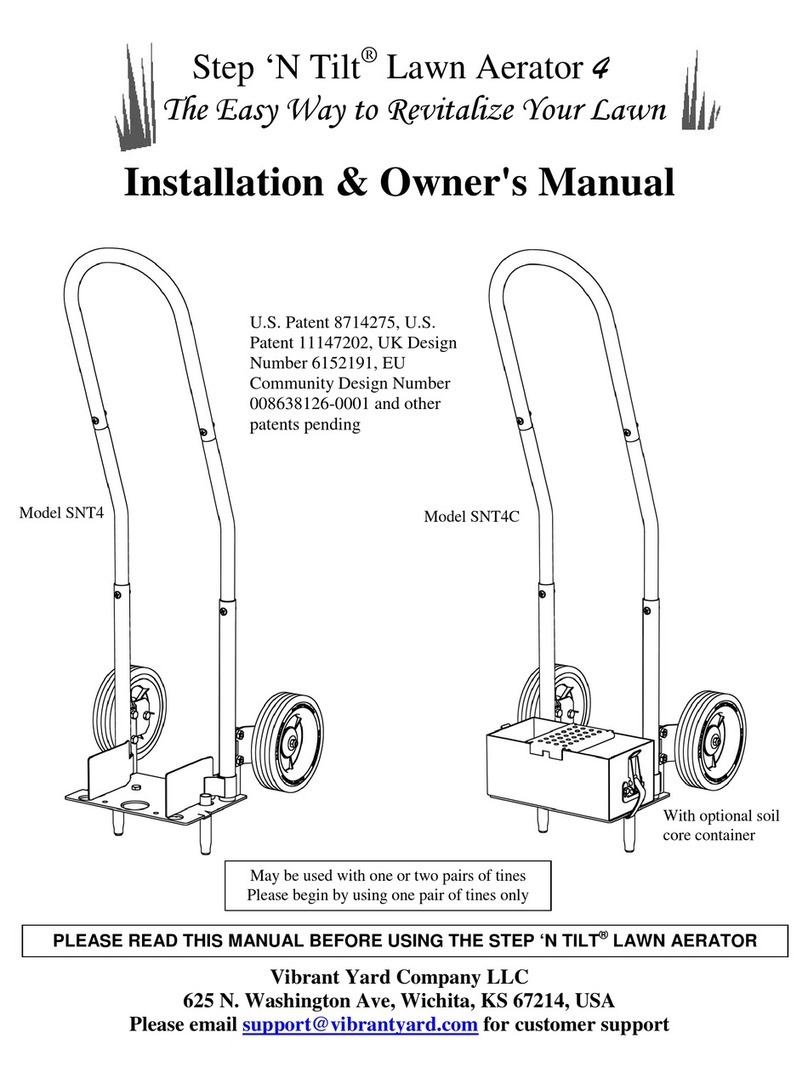
Vibrant Yard
Vibrant Yard Step 'N Tilt Lawn Aerator 4 Installation & owner's manual
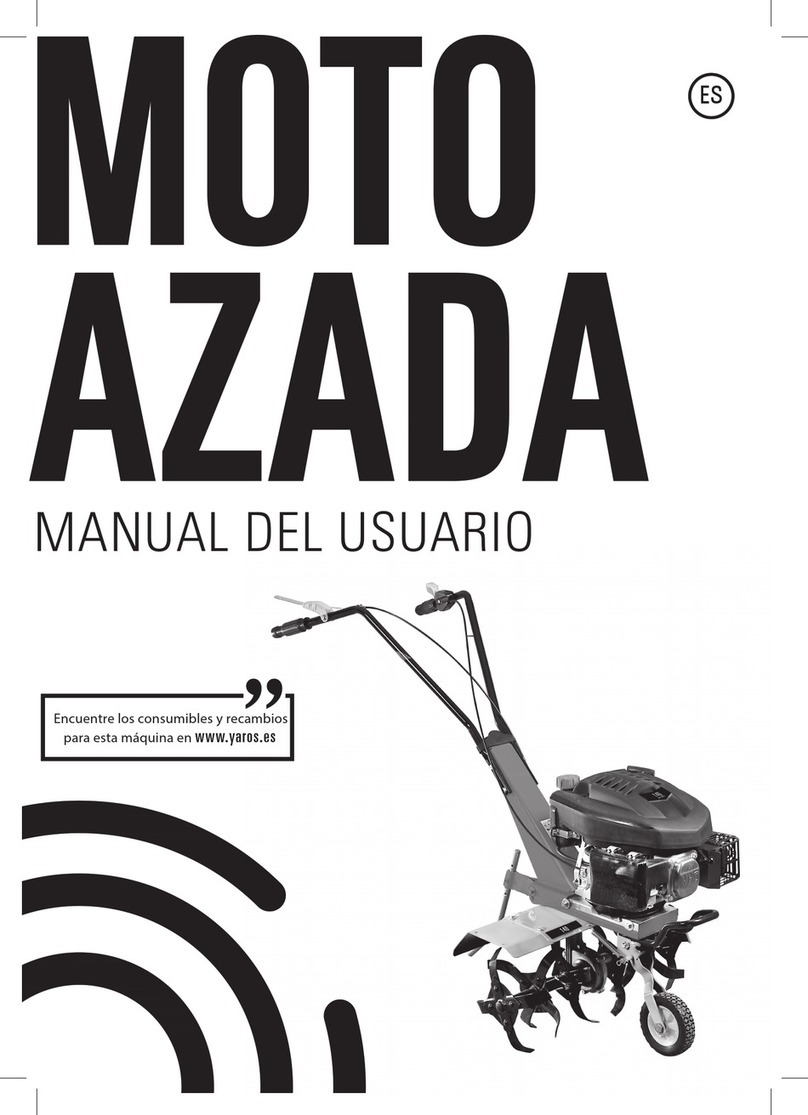
Yaros
Yaros 140 user manual
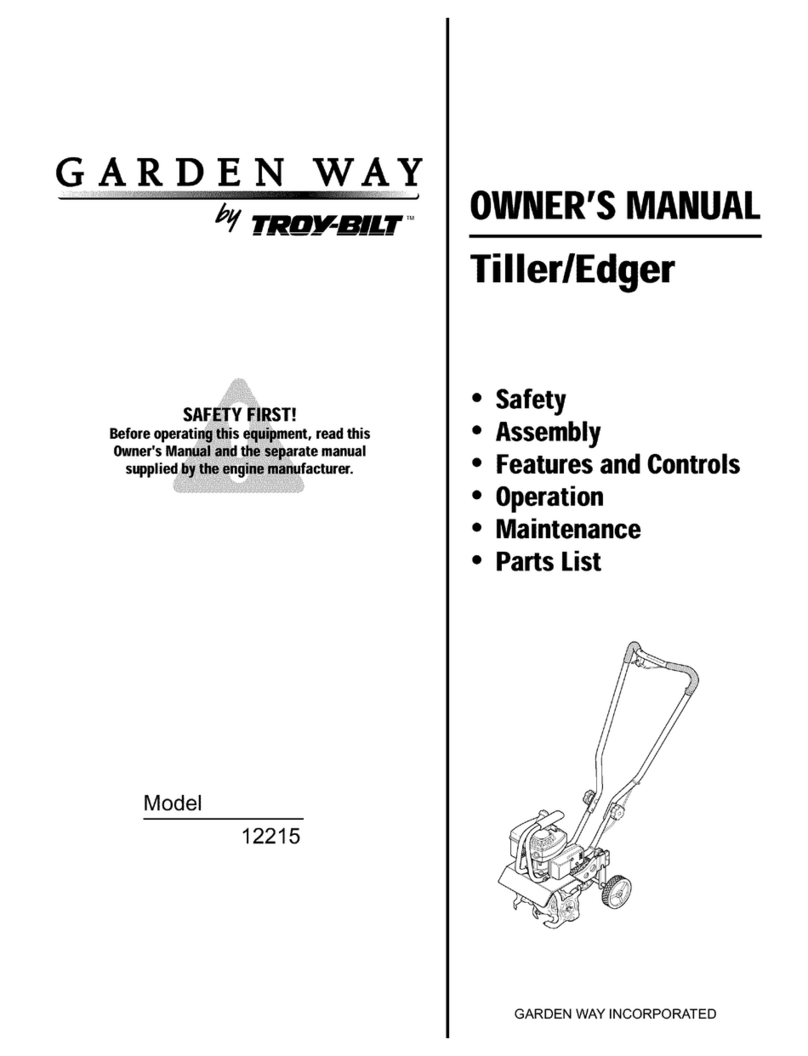
Troy-Bilt
Troy-Bilt Garden way 12215 owner's manual
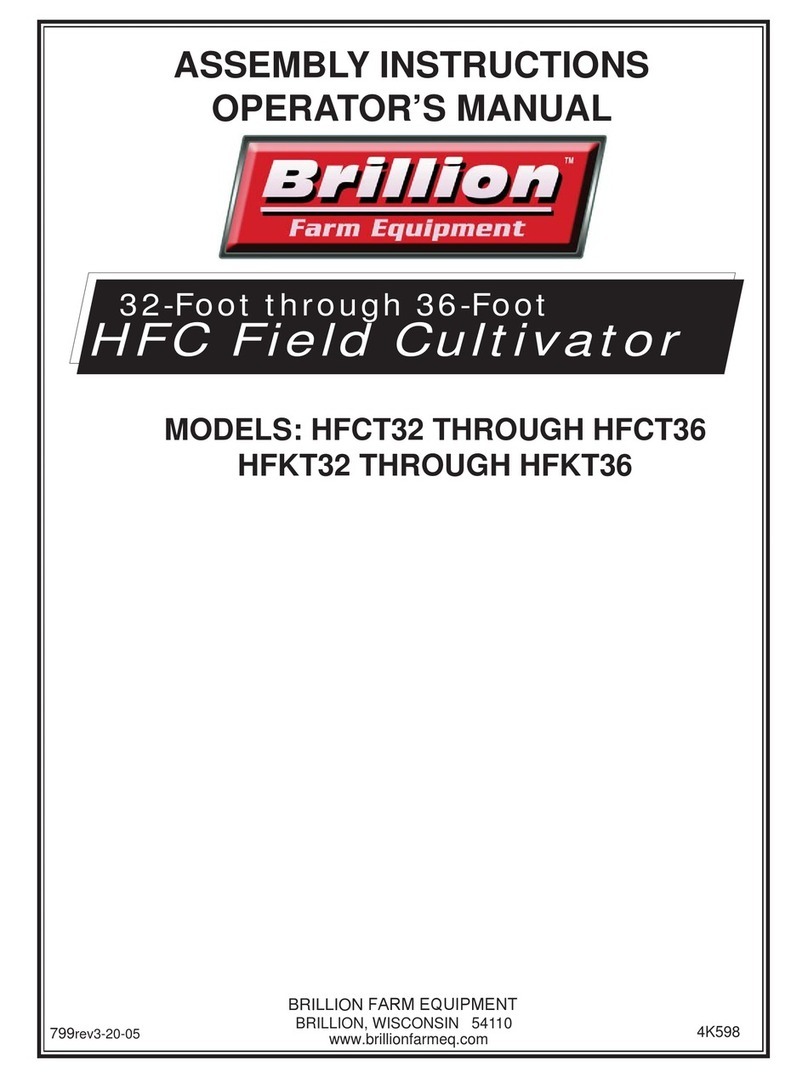
Brillion
Brillion HFC Series Assembly instructions operator's manual

Bosch
Bosch ALR 900 Original instructions

Texas
Texas BC 3.5 Agita operating instructions
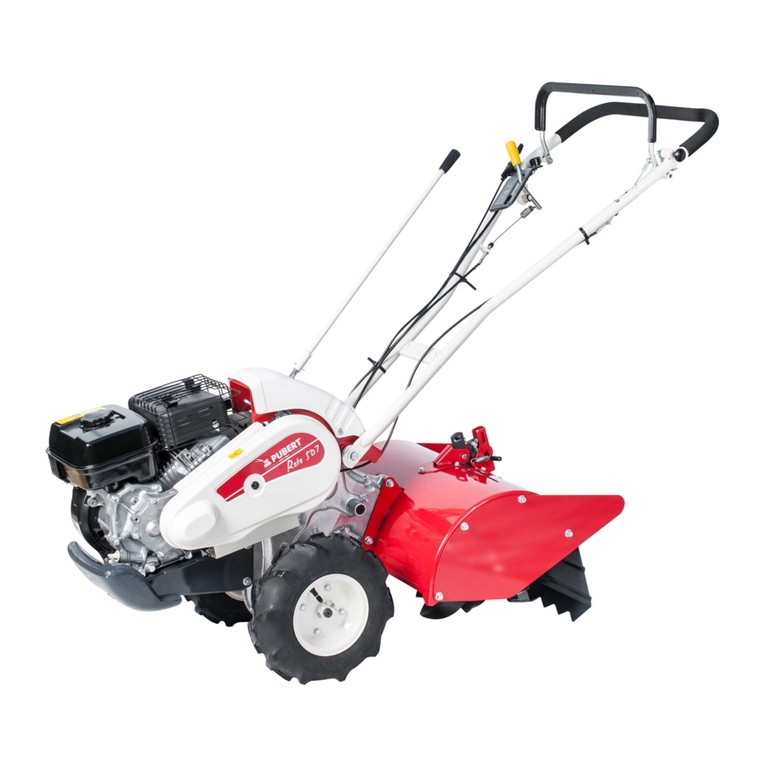
Pubert
Pubert ROTO 507 Instruction for use - Original notice

Brinly-Hardy
Brinly-Hardy AS-30 BH owner's manual
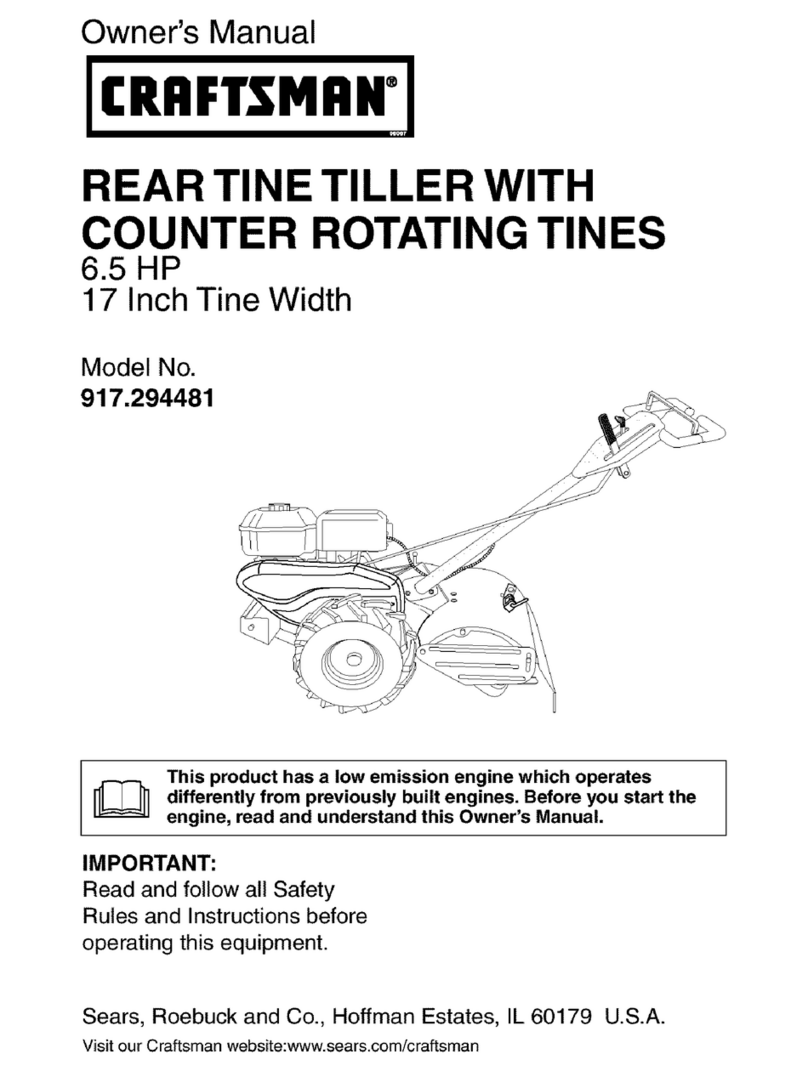
Craftsman
Craftsman 917.294481 owner's manual
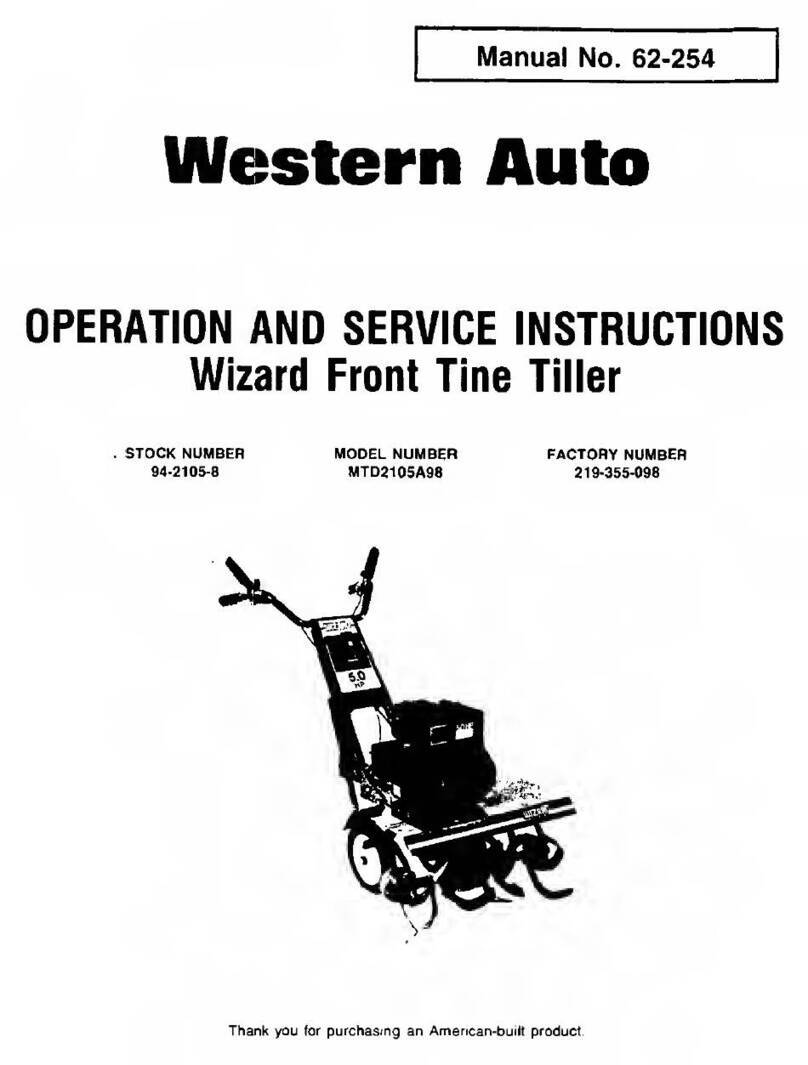
Western Auto
Western Auto Wizard MTD2105A98 Operation and service instructions

Mantis
Mantis Tiller owner's manual
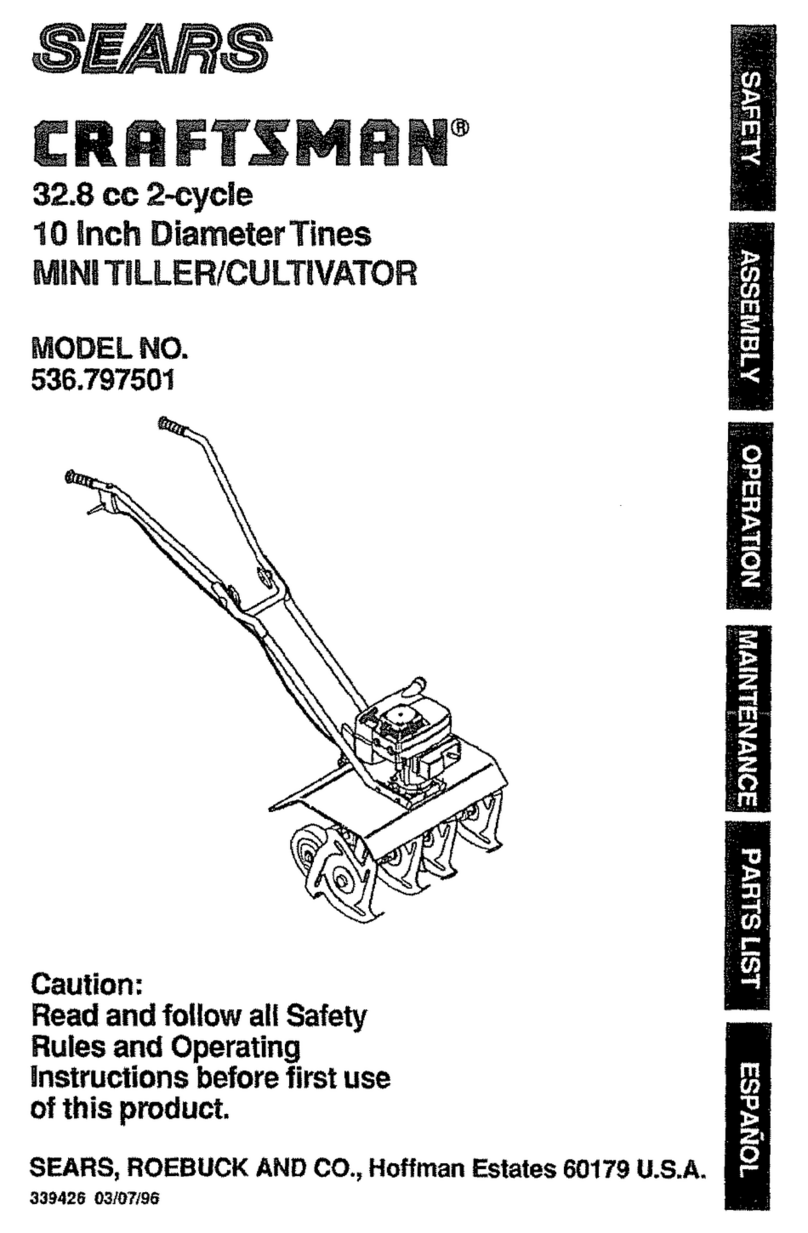
Craftsman
Craftsman 536.797501 operating instructions
